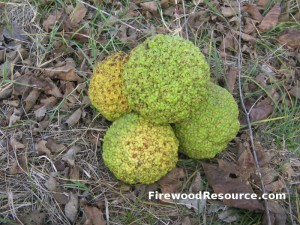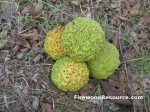
Osage orange firewood is known as being an extremely hot burning firewood. It may be the hottest burning and hardest wood east of the Rockies. Hotter than oak,hickory and any of the other Eastern hardwoods. It is said to burn as hot as coal.
Osage orange Maclura pomifera, also known as, bois d’arc, bodark, or bodock, hedge, hedge apple horse apple, has been known to warp wood stoves because it burns so hot. Caution should be used not to load up a wood stove with too much of it.
This does not mean it is not good firewood, some people love to burn it, you just have to be careful with it and keep your fires smaller than you would with other woods. This can be easier to do with air tight stoves where you can regulate the air intake.
Osage orange can be hard to cut and hard to split. It is best to cut and split it while it is still green.
This is another wood that is very decay resistant and makes great fence posts. Its hard dense woods are used for archery bows, wood turning and small crafts.
Post your experience with osage orange firewood below.

We burn osage orange all the time and love it. We lined our fireplace with soapstone firebrick an it holds up well to the heat. For the really cold nights it is the best but when it isnt so cold it can sometimes be too hot. Thats when we burn oak cedar and other wood. It cuts and splits best green. If it gets dry you are going to have a harder time with it.
I use osage orange in a wood boiler, since the steel is surrounded by water the steel cannot get to hot to turn red or have a chance to warp. so load boilers to the top and the wood last a long time.
Ive found that splitting osage orange is best done while it is frozen. Usually around 10 to 20 degrees Fahrenheit is sufficient.
Thanks for the great tip Jeff.
I have even heard Old Sage Orange call Iron Wood, due to the fact that chainsaws have been known to spark when cutting this wood.
I recommend planting o.o. to replace ash trees. Aside from its awesome wood properties it is remarkably insect and disease resistant, drought and flood tolerant, will grow in poor soil, and is available in a male thornless variety. ISA Certified Arborist MN-4075A
I’m in eastern mass. ,any idea where I can buy it, and the tree? thanks
Where does it grow
Originally from Oklahoma and Texas but has been planted throughout much of the US, mostly the Eastern US. Probably some in Canada too.
I’ve got a farm I cleaned up a year and a half ago and the entire fence row was overrun with bodock. I cut 80 trees up to 34″ in diameter with the sap down. I read this article because I have so much. I built a wood stove out of a full sheet and a half of 1/4″ cold rolled steel and 24′ of 2″ angle iron with a half inch door, bottom line with fire brick the stove itself is in a two stair step design. I built it big enough to be able to put two 2’x18″ logs plus all the little stuff in between. I cut and burnt my first week worth this week. It’s comparable to pecan #my fav. The wood is one year seasoned and I love it! Thanks y’all
Another neat benefit of this wood is it simply will not rot. I have pulled some out of a pile that’s been pushed up for more than 10 years and it burns great. It can but a little difficult to get started but once it goes it lasts and lasts.
Hawk
I took out a hedge row of Osage orange and still have 10-20 cords to cut up five years later. And it is hard to cut. Chain saw blades have to be sharpened often. I have a 30 ton splitter and it struggles at times to split it.
To light it I use other wood to start it burning. But when it gets going it burns like coal. But you want a door on your stove as it sometimes puts on a fireworks display that is awesome.
I live one hour south of Albany ny in Schoharie county. I burn 8 cords of wood a year, for heat and year round hot water. Sure would be very cool if someone could point me in the right direction where I might be able to get permission from a land owner to cut some Osage to mix in my winter firewood pile!!!
Here in Kansas, we call it Hedge, I always wondered what Osage Orange was. It is very good but you do need to be able to close it up because it really lights up a room with sparks. I have customers that but it and really are happy. It is one my higher priced woods also.
So I must assume that this super wood takes twice as long to season as common hardwoods? I would set this aside for fence posts and timber wood for the construction of strong structures.
Everything is built with pine and plastic now I couldn’t even find replacement cedar clapboards for my garage recently every one now are greedy cheap asses.
If you ever plant it on your land you will wish you didn’t because it will take over and you can’t get rid of it
Can’t agree Norman. I have it here and there all over my 90 acres in NE Oklahoma and I highly value it. Wonderful natural resource. It’s heating my 1947 house right now.
You can burn this wood weeks after you cut it. Albeit, it won’t heat as well of some that has dried for a year. It’s bright yellow when you split it, then will turn orange, then finally gray. It’s considered a nuisance to farmers here in Kansas, so they are happy for you to go take it off of their land. And I’m glad they want us to take it. This stuff will grow horizontally out of a creek bed. It burns a long time, and burns hot.
I think I have cut a tree but it does not split well while freshly cut. Should I let it age?
As a kid, my aunt and uncle heated their house with a pot bellied wood cookstove. I remember my aunt and uncle going out and cutting hedge. They told me it was the best wood to use for firing up a stove. So many wonderful memories around that cook stove.
Best firewood there is. If you can sharpen your saw properly you will not have problems cutting it! Splits easy for me with splitting maul if it’s straight. If twisted use a log splitter for sure.
Not sure why I’m seeing comments about Hedge being hard to split. When it’s seasoned it a like splitting butter. Elm is the worst. It burns very hot. And pops. I live in Kansas and it’s our most abundant tree.
I live about an hour outside Montreal and I have O’Sage Orange on my property. Planted 10 from seeds obtained in Southwestern Ontario. Out of the 10 two survived and to my surprise one male and one female. Now I have the fruit as well. I also tried Sassafras from a sapling an it is also fully grown.
I have some 8 inch diameter corner posts that my grandfather put in. They are solid and strong and hard. Good luck putting a nail into it. I’ve sheared off drill bits while trying to drill a hole for a nail to get in there!
Around here (SW Missouri) it is hard to kill out (not that I want to kill it all). It grows back from the growth ring of large stumps.
Because of the thorns, the extension agency sold the farmers on the idea that ‘they would never have to build another barbed wire fence, if this was planted in the fence rows’. So it’s everywhere here.
We use it for posts, when we can get one straight enough. It’s also my favorite firewood, especially if someone else is cutting it. It sure can dull a chainsaw quickly and does indeed create sparks while cutting, that you can easily see toward dusk.
Speaking of sparks, when you’re burning it, some pieces shower you with sparks as it burns and has a lot of oxygen. Sparks will shoot two feet out of the stove and then explode into a dozen other sparks, some of which will also explode! I’ve had the sparks showering out of my 20 ft chimney, when I burned a stove full of it (don’t ever do that! ).
Use it mixed with other wood and it’ll burn hotter than hot. Be careful you don’t warp your sheet metal stoves, by burning too much too quickly. My stove is an old Ashley that I can only only control the burn rate so much. So I have to control how much and how seasoned. Fresh cut will burn all night long. Three years seasoned, when it’s lost its orange color, it’ll start on its own coals as easy as age’d pine needles would.
With all that said, I love it as firewood. I can put a single large round in and have it keep the stove very hot and leave strong coals several hours later. Careful though, those coals can start sparking when messed with, even after all that time.
It’s a rare tree, in my opinion, that is worth cutting and burning logs the size of your wrist.
In the fence rows, it’ll keep spreading unless you can get under the canopy while brush hogging. Takes good tires to handle the thorns, though not as long as black locust thorns, they are still a force to be reckoned with.
And finally, my 120+ old farm house has floor and wall supports directly on the ground with no termite damage. I don’t know if it has chemicals that keep microbes and termites from eating it, or if it’s just too darn hard!!
My experience with Hedge here in Kansas is that it is great Firewood the longer mine has seasoned the less sparking I get. My understanding is it was planted after the dirty 30s to keep down erosion, like others have said a fence post can outlast a persons life. Generations remember being told that Fence was there when we bought the farm or that your grandpa put up that fence before you were born
Well, I have been reading about osage orange being great firewood but didn’t have a clue as to what it was….till I saw a picture of the fruit, in this article. Holy hell, that’s a hedge apple!! I had no idea. Thanks for the info, I’ll be keeping an eye out for this stuff!!
Illegal to sell as firewood in TX, but in my enclosed stove really heats the house. Rigged wood splitter to work off Bobcat hydraulics since small engines are real pain to keep running. 1/2 throttle on Bobcat will split anything I can get onto splitter. Does work best if wood is green, but dryer wood is easy.